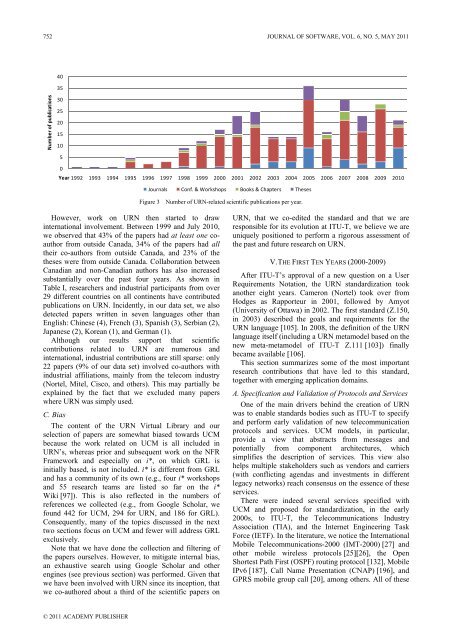Journal of Software - Academy Publisher
Journal of Software - Academy Publisher
Journal of Software - Academy Publisher
You also want an ePaper? Increase the reach of your titles
YUMPU automatically turns print PDFs into web optimized ePapers that Google loves.
752 JOURNAL OF SOFTWARE, VOL. 6, NO. 5, MAY 2011<br />
Number <strong>of</strong> publications<br />
40<br />
35<br />
30<br />
25<br />
20<br />
15<br />
10<br />
5<br />
0<br />
Year 1992 1993 1994 1995 1996 1997 1998 1999 2000 2001 2002 2003 2004 2005 2006 2007 2008 2009 2010<br />
<strong>Journal</strong>s Conf. & Workshops Books & Chapters Theses<br />
Figure 3 Number <strong>of</strong> URN-related scientific publications per year.<br />
However, work on URN then started to draw<br />
international involvement. Between 1999 and July 2010,<br />
we observed that 43% <strong>of</strong> the papers had at least one coauthor<br />
from outside Canada, 34% <strong>of</strong> the papers had all<br />
their co-authors from outside Canada, and 23% <strong>of</strong> the<br />
theses were from outside Canada. Collaboration between<br />
Canadian and non-Canadian authors has also increased<br />
substantially over the past four years. As shown in<br />
Table I, researchers and industrial participants from over<br />
29 different countries on all continents have contributed<br />
publications on URN. Incidently, in our data set, we also<br />
detected papers written in seven languages other than<br />
English: Chinese (4), French (3), Spanish (3), Serbian (2),<br />
Japanese (2), Korean (1), and German (1).<br />
Although our results support that scientific<br />
contributions related to URN are numerous and<br />
international, industrial contributions are still sparse: only<br />
22 papers (9% <strong>of</strong> our data set) involved co-authors with<br />
industrial affiliations, mainly from the telecom industry<br />
(Nortel, Mitel, Cisco, and others). This may partially be<br />
explained by the fact that we excluded many papers<br />
where URN was simply used.<br />
C. Bias<br />
The content <strong>of</strong> the URN Virtual Library and our<br />
selection <strong>of</strong> papers are somewhat biased towards UCM<br />
because the work related on UCM is all included in<br />
URN’s, whereas prior and subsequent work on the NFR<br />
Framework and especially on i*, on which GRL is<br />
initially based, is not included. i* is different from GRL<br />
and has a community <strong>of</strong> its own (e.g., four i* workshops<br />
and 55 research teams are listed so far on the i*<br />
Wiki [97]). This is also reflected in the numbers <strong>of</strong><br />
references we collected (e.g., from Google Scholar, we<br />
found 442 for UCM, 294 for URN, and 186 for GRL).<br />
Consequently, many <strong>of</strong> the topics discussed in the next<br />
two sections focus on UCM and fewer will address GRL<br />
exclusively.<br />
Note that we have done the collection and filtering <strong>of</strong><br />
the papers ourselves. However, to mitigate internal bias,<br />
an exhaustive search using Google Scholar and other<br />
engines (see previous section) was performed. Given that<br />
we have been involved with URN since its inception, that<br />
we co-authored about a third <strong>of</strong> the scientific papers on<br />
© 2011 ACADEMY PUBLISHER<br />
URN, that we co-edited the standard and that we are<br />
responsible for its evolution at ITU-T, we believe we are<br />
uniquely positioned to perform a rigorous assessment <strong>of</strong><br />
the past and future research on URN.<br />
V. THE FIRST TEN YEARS (2000-2009)<br />
After ITU-T’s approval <strong>of</strong> a new question on a User<br />
Requirements Notation, the URN standardization took<br />
another eight years. Cameron (Nortel) took over from<br />
Hodges as Rapporteur in 2001, followed by Amyot<br />
(University <strong>of</strong> Ottawa) in 2002. The first standard (Z.150,<br />
in 2003) described the goals and requirements for the<br />
URN language [105]. In 2008, the definition <strong>of</strong> the URN<br />
language itself (including a URN metamodel based on the<br />
new meta-metamodel <strong>of</strong> ITU-T Z.111 [103]) finally<br />
became available [106].<br />
This section summarizes some <strong>of</strong> the most important<br />
research contributions that have led to this standard,<br />
together with emerging application domains.<br />
A. Specification and Validation <strong>of</strong> Protocols and Services<br />
One <strong>of</strong> the main drivers behind the creation <strong>of</strong> URN<br />
was to enable standards bodies such as ITU-T to specify<br />
and perform early validation <strong>of</strong> new telecommunication<br />
protocols and services. UCM models, in particular,<br />
provide a view that abstracts from messages and<br />
potentially from component architectures, which<br />
simplifies the description <strong>of</strong> services. This view also<br />
helps multiple stakeholders such as vendors and carriers<br />
(with conflicting agendas and investments in different<br />
legacy networks) reach consensus on the essence <strong>of</strong> these<br />
services.<br />
There were indeed several services specified with<br />
UCM and proposed for standardization, in the early<br />
2000s, to ITU-T, the Telecommunications Industry<br />
Association (TIA), and the Internet Engineering Task<br />
Force (IETF). In the literature, we notice the International<br />
Mobile Telecommunications-2000 (IMT-2000) [27] and<br />
other mobile wireless protocols [25][26], the Open<br />
Shortest Path First (OSPF) routing protocol [132], Mobile<br />
IPv6 [187], Call Name Presentation (CNAP) [196], and<br />
GPRS mobile group call [20], among others. All <strong>of</strong> these

















